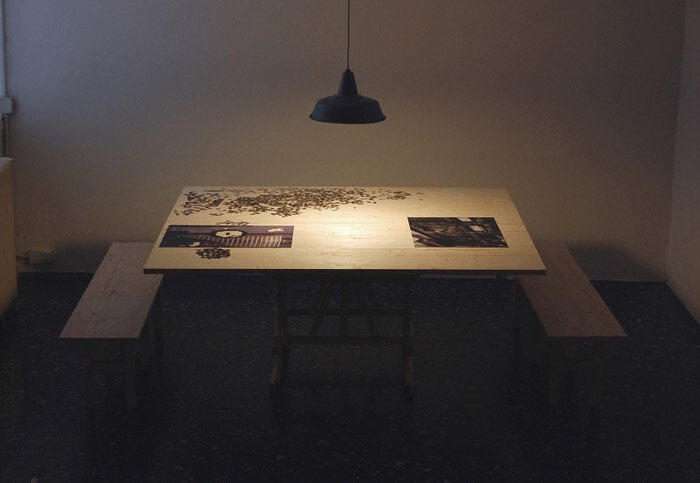Mario Garcia Torres is well acquainted with the past of Peep-Hole, one the newest non-profit spaces run by three curators in Milan. In fact, he not only alluded to it, but he also enhanced its weight. In a letter given to the visitor, the artist stated his wish to “create a certain atmosphere (…) an overall parenthesis, a space between time.” When entering the exhibition one has the impression of stepping inside a black-and-white film, for the presented works fit well within a palette of greys that is enhanced not only by the general darkness of the space, but also by a suave, constant melody that gives a peculiar tone to the whole place.
“I Will Be With You Shortly” is the first solo show of Garcia Torres in Milan and – as suggested by its title – it is an exhibition that deals with deferral, anticipation, expectation, and waiting. Despite its lascivious name, Peep-Hole is located in a historical place: in the early 1990s, it hosted Massimo De Carlo’s first gallery which then became an artist’s studio until its most recent incarnation.
The main room is very dim, only broken by two light sources. On the left, a ceiling lamp beams on the top of a large, square, wooden table that displays four incomplete puzzles. They are surrounded by the remaining pieces, and it is tempting to stay there trying to complete the jigsaws. Each shows a different picture of a public clock in Milan, all at a different time. Time to Piece (2010) is a work that simultaneously gives and takes: on the one hand, it displays exactly what it tries to seize – time; on the other hand, it exhibits the amount of time that previous visitors have spent on it. Characteristic of his artistic practice, close to that of a researcher, Garcia Torres establishes a connection between two references dear to him: that of the puzzle works exhibited by Gonzalez-Torres exactly in that space in 1991, as well as an allusion to the puzzles of Alighiero Boetti.
In the same room is May 2010 (Pocket Scratching Series) (2010), whose title is also elucidative as it consists of the projection of a 35mm transparent slide that was carried over the course of a month in the artist’s pocket. It shows the residues accumulated on its surface during this period, and once again, different layers of time are condensed within that single image in which different textures and tiny irregularities gain pictorial concreteness. Formally similar to Rauschenberg’s Erased de Kooning Drawing (1953), one cannot avoid thinking about the practices of accumulation and subtraction – a recurrent element in concept-based approaches to art.
As well as repetition: in fact, the constant background refrain invading the space leads us towards the office, where a record player reproduces the musical version of an old work, I Promise Every Time (2008). This piece, a collaboration with the musician Mario Lopez Landa, goes beyond pure ambition (the former work consisted of a written vow in which Garcia Torres pledged to continue doing good art): done in this repetitive way, it becomes yet another tribute to conceptual art heritage, in this case to Baldessari’s I will not make any more boring art (1971). It is yet another promise, similar to that enunciated in the title of the show, as the artist, once again, assumes a compromise with the viewer. In this specific case, it is difficult to conceive a stronger clash with Adorno’s “On the Fetish-Character in Music and the Regression of Listening” (1938) especially this being a seductive popular song. But still, it is a very successful form of wishful thinking.
And yet again another vow: as part of the project, Garcia Torres showed Unspoken Dailies (2003-2009). a feature film made about a never-published text written by the artist about Bas Jan Ader. The silent black-and-white film depicts an absorbed actor, Diego Luna, who reads the text in real time. At the end, he tears the letter to pieces. During its 66 minutes what the viewer is offered is the possibility of perceiving time in its purest form. A clock hanging on the wall behind the actor makes it even more evident.
Sometimes it is as if Godard’s genial and vibrant minute of silence of Bande à part (1964) was dilated to an unbearable extension. It is so moving you feel like crying. Time is not flying: it is being observed.





